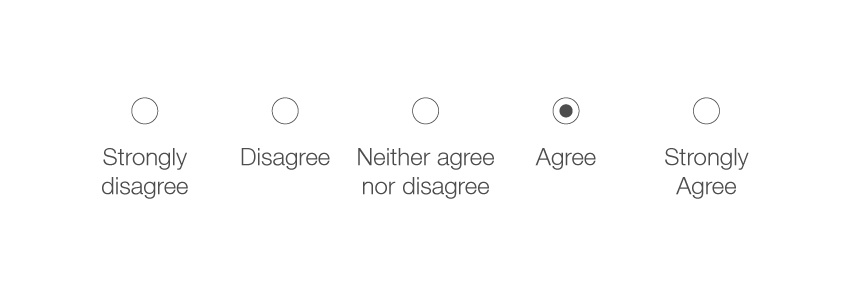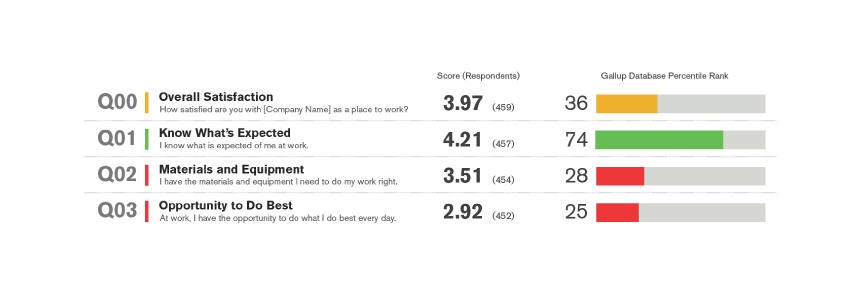10 Employee Pulse Survey Questions You Should Be Asking Your Employees

Employee pulse surveys are hard to get right. To make any survey worthwhile, you need to ask questions that will get truly actionable responses. Responses that are measurable and insightful, and that reveal something about employee engagement. Responses that tell you what’s working, what’s not, and how to make things better.
The trick to getting survey responses you can actually do something with is asking the right questions, the right way.
Sure, there are general rules for what makes a good employee survey question — be clear, have focus, and don’t ask leading questions — but it’s easy to get wrong and knowing where to start can be hard.
What type of survey questions should you ask employees?
There are many different types of employee surveys, and each one tends to favor different question styles over others.
For simplicity’s sake, we’re going to focus on employee pulse surveys, because they’re quicker to create, easier to manage and analyze, and typically have higher response rates.
What is an employee pulse survey?
Pulse surveys are single-question employee surveys that you can send out over email, post on your intranet, or put out over whatever digital internal comms channel best suits the employees you want to reach.
The best thing about employee pulse surveys is that they are fast and frequent.
As per the name, they’re meant to help you “take the pulse” of your organization and get a snapshot of employee views on specific topics. They’re conducted quickly and regularly, unlike the tedious annual surveys that many of us know are still painfully popular.
Using pulse surveys in internal comms
A good employee pulse survey contains one or a short series of specific, standalone questions. Because each question relates to a specific topic, you don’t need employees to answer the full survey in order to still come away with actionable results.
Pulse survey questions usually use a fixed measurement scale for responses, like the five-point Likert scale. If you’ve ever taken a survey, there’s a good chance you’ve come across a Likert scale. It aims to capture responses from one extreme to the other (like ranging from “strongly disagree” to “strongly agree”), and helps employers quantify emotions and attitudes.
Using a fixed scale standardizes responses, making the results specific and measurable.

What are the benefits of employee pulse surveys?
Employee pulse surveys are a powerful tool for organizations striving to improve employee engagement and drive positive change. These surveys provide a quick and efficient means of gathering actionable insights into various aspects of the employee experience. By focusing on specific topics and utilizing single-question formats, pulse surveys enable organizations to swiftly assess employee sentiments on key issues. Unlike traditional annual surveys, pulse surveys are conducted frequently, allowing organizations to stay attuned to the evolving needs and concerns of their workforce. Moreover, pulse surveys typically have higher response rates, ensuring more comprehensive and representative feedback. This regular feedback loop empowers organizations to identify areas of success and areas for improvement, ultimately fostering a culture of continuous growth and enhancement.
What are the best employee pulse survey questions?
Every organization is unique, so there is no standardized “perfect” employee survey — pulse or otherwise. Nevertheless, Gallup has set the standard with their Gallup Q12.
Based on research into survey responses from over 25 million employees worldwide, and 12 pulse survey-style questions, Gallup claims they have gained insight into the “12 elements of employee engagement.”
For inspiration into your own employee survey questions, especially given the research that’s gone into the Gallup Q12, it’s definitely worth taking a look at the questions they use.

However, not everyone agrees that the Q12 takes the best approach. And there are plenty of alternatives.
For instance, Best Companies have devised their own employee survey, the b-Heard, which targets what they see as the 8 factors of workplace engagement. It asks employees 70 questions, with answers given on a seven-point scale.
How we chose our 10 best employee pulse survey questions
We admit it: The employee pulse survey questions we recommend below take inspiration from the Q12.
They’re short and specific (as pulse survey questions should be), are designed to be answered on a fixed scale of agreement, and cover every aspect of employee engagement — from job satisfaction and professional development opportunities, to employees’ feelings about their teams, managers, and company.
And while we’ve taken inspiration from Gallup, our questions have also been carefully developed and selected through conversations with internal communication professionals who use them.
The 10 questions you should be asking employees
For each of our 10 questions we’ve given a brief explanation of the insights you’re likely to get from your responses. Unless otherwise stated, the questions (or statements) are designed to be answered on a five-point Likert scale, as below:
Strongly disagree | Disagree | Neither agree nor disagree | Agree | Strongly agree
1) How happy are you at work?
What it will tell you: Are employees generally happy in their job? Do they enjoy where they work and what they do?
Response scale: Very unhappy | Somewhat unhappy | Neutral | Somewhat happy | Very happy
2) I know what constitutes good performance in my role
What it will tell you: Do employees feel like their job role is clearly defined? Do they have clear goals and objectives and know how their performance is assessed?
3) I have access to everything I need to perform to the best of my ability
What it will tell you: Do employees have the equipment and resources they need to fulfill their job role effectively? Are there any obstacles to them carrying out their responsibilities?
4) I receive meaningful recognition for doing good work
What it will tell you: Do employees feel valued? Do they feel like their work and achievements are appreciated?
5) I feel comfortable giving opinions and feedback to managers
What it will tell you: Are there strong working relationships between employees and managers in your workplace? How open is the company culture?
6) On a scale of 1–10, how would you rate your work-life balance?
What it will tell you: Do employees feel like too much is expected of them? Are working hours too long and is the working culture too demanding or stressful?
Response scale: Rating from 1–10 with 1 indicating a very poor work-life balance, 10 an extremely good one.
7) My personal values align with the company’s vision and mission
What it will tell you: Do employees share your company values? Do they feel personally connected with what your company does or stands for?
Response scale: Strongly disagree | Disagree | Neutral | Agree | Strongly Agree | Not sure what the company vision/mission is
8) How likely are you to recommend your organization’s products or services to a friend?
What it will tell you: Are your employees proud to work for your company? Do they believe in what your company does or produces? Do they talk positively about their job outside of work?
Response scale: Rating from 1–10 with 1 being “Not at all likely,” 10 being “Extremely likely.”
Related: How to calculate employee advocacy with NPS-style surveys
9) I am given opportunities to learn and develop my skills
What it will tell you: Do employees feel like they‘re encouraged to learn new skills? Is there enough focus on personal development by the company and by managers?
10) I can see clear career progression in my role
What it will tell you: Do employees feel like there are sufficient opportunities to progress within the company? Are managers supportive of career development? Do employees feel like they have a future at the company?
How can you implement pulse surveys in your internal communications?
Now that you have some questions to get you started, you need to get them out to employees to start collecting that juicy data.
There are a number of ways you might be able to implement pulse survey questions into your day-to-day internal communications, but it’s always easier when you have dedicated tools for the job.
Staffbase’s survey tools allow you to send questions directly to employees via email, embedded in your regular employee newsletter, straight to your employees’ phones via the company mobile application, or even on your intranet.
This flexibility allows you to collect responses from every employee, from corporate to the front line, so you can get better data and a clearer picture of the needs of your workforce.
Our tools make it possible to customize your questions, collect responses, visualize the data, track trends, and give every employee in your organization a voice.
How to measure employee pulse surveys
Measuring employee pulse surveys requires actively analyzing the responses provided by employees. This entails scrutinizing the collected data to identify emerging trends, recurring patterns, and potential areas for improvement. Organizations must quantify and categorize the responses to gain valuable insights into employee sentiments on specific topics. Active utilization of analytical techniques such as statistical analysis and data visualization aids in effectively interpreting the survey results. Furthermore, actively comparing responses over time and across different departments or teams allows organizations to track changes and pinpoint areas requiring attention. This ongoing evaluation enables organizations to adapt strategies and foster continuous improvement in employee engagement and satisfaction.
Want to learn more about Staffbase’s internal communications surveying tools? Read more here.
Frequently asked questions about employee pulse surveys
What is a pulse survey?
A pulse survey is a single-question or short series of questions employee survey that provides quick snapshots of employee opinions and attitudes on specific topics. They are conducted frequently and aim to capture real-time feedback from employees.
How many questions should a pulse survey have?
Pulse surveys typically consist of one or a few specific, standalone questions. They are designed to be quick and easy to answer, ensuring higher response rates and providing actionable insights.
Why is it called a pulse survey?
It’s called a “pulse survey” because it’s meant to help organizations “take the pulse” of their workforce. Like checking a pulse for vital signs, these surveys provide quick snapshots of employee sentiments on specific topics.
What is the difference between a survey and a pulse survey?
While traditional surveys may be longer and cover a wide range of topics, pulse surveys are shorter and more focused. Pulse surveys are conducted more frequently, often on a weekly or monthly basis, to track changes in employee attitudes and perceptions over time.
What to do with pulse survey results?
Pulse survey results should be carefully analyzed to identify trends, patterns, and areas for improvement. Organizations can use the insights gained from pulse surveys to make data-driven decisions, address issues, and enhance employee engagement and satisfaction.
How often should you do pulse surveys?
The frequency of pulse surveys depends on the organization’s goals and needs. They can be conducted weekly, biweekly, or monthly to track changes in employee sentiment and engagement over time.
How to introduce a pulse survey to employees?
Introducing a pulse survey to employees involves clearly communicating its purpose, benefits, and how their feedback will be used. Organizations can use various communication channels such as email, intranet, or company meetings to inform employees about the survey and encourage participation.











